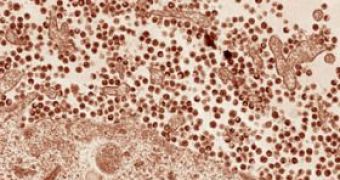Great hope for the 25-40 million HIV positive people in the world: researchers at Rockefeller University and the Aaron Diamond AIDS Research Center, who published their research in the journal "Nature", have detected a molecule on the surface of human cells that stops the spread of mutant strains of HIV, when AIDS is triggered.
The new protein impedes the virus to spread, which would infect more cells, by sticking the viruses to the parent cell's external side of the membrane.
The team had found in 2006 that HIV viruses could pass through the sticky membrane helped by a protein named Vpu. But the team was interested on the source of the glue: it has been found to be the "tetherin" protein.
"All we knew when we started this two and a half years ago was that a virus lacking Vpu was released less efficiently from cells. And we had some electron micrographs that showed virus particles stuck there on the surface and clustered inside cells," said lead researcher Paul Bieniasz, head of the Laboratory of Retrovirology and ADARC scientist.
The antiviral protein sticking the HIV mutant viruses to the cell was found to impede the spread of other encapsulated viruses, as well. The team focused on cells requiring Vpu for HIV, so that the virus could be released. This way, they detected the tetherin protein: viruses lacking Vpu in the presence of tetherin got glued on piles on the cell surface. In the absence of tetherin, viruses devoid of Vpu could get out of the cells easily.
"We've discovered a new way that cells defend themselves against viruses. I think this will open up a new area of study in virology: how this protein antagonizes other viruses, and how viruses learn to get around it," said Bieniasz.
The team is going to assess how powerful is the antiviral activity of tetherin and whether variations in its structure are connected to increased or decreased anti-HIV and antiviral activity. By manipulating the interaction tetherin-Vpu, we could find an anti-AIDS treatment. Who knows, maybe this is what we've been looking for...

 14 DAY TRIAL //
14 DAY TRIAL //